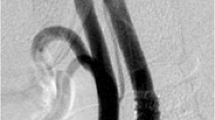Summary
Both open and closed loop self-expandable stents were used in carotid artery stenting (CAS) for carotid bifurcation stenosis. We sought to compare the efficacy of two types of stents in CAS. The data of 212 patients treated with CAS (42 and 170 cases implanted with closed and open loop stents, respectively) for carotid bifurcation stenosis and distal filtration protection devices were retrospectively analyzed. Between closed and open loop stents, there were no significant differences in hospitalization duration, NIHSS score before and after the treatment, stenosis at 12th month, and cumulative incidence of primary endpoint events within 30 days or from the 31st day to the 12th month; while there were significant differences in hemodynamic changes and rate of difficulty in recycling distal filtration protection devices. Use of open vs. closed loop stents for carotid bifurcation stenosis seems to be associated with similar incidence of complications, except for greater rate of hemodynamic changes and lower rate of difficulty in recycling the distal filtration protection devices.
Similar content being viewed by others
References
Ricotta JJ, Aburahma A, Ascher E, et al. Updated Society for Vascular Surgery guidelines for management of extracranial carotid disease: executive summary. J Vasc Surg, 2011,54(3):832–836
Committee CS. Carotid Revascularization Using Endarterectomy or Stenting Systems (CaRESS) phase I clinical trial: 1-year results. J Vasc Surg, 2005,42(2): 213–219
Neurology Branch, Chinese Medical Association. The ischemic stroke secondary prevention guideline writing group of cerebrovascular disease group. Chinese secondary prevention guideline for ischemic stroke and transient ischemic attack (2010). Chin J Neurol, 2010,43(2):154–160
Kernan WN, Bruce O, Black HR, et al. Guidelines for the prevention of stroke in patients with stroke and transient ischemic attack: a guideline for healthcare professionals from the American Heart Association/American Stroke Association. Stroke, 2014,45(7):2160–2236
Birns J, Qureshi S, Chen R, et al. Endovascular stroke therapy. Eur J Intern Med, 2014,25(7):584–591
Meyers PM, Schumacher HC, Connolly ES, et al. Current status of endovascular stroke treatment. Circulation, 2011,123(22):2591–2601
Trocciola SM, Chaer RA, Lin SC, et al. Analysis of parameters associated with hypotension requiring vasopressor support after carotid angioplasty and stenting. J Vasc Surg, 2006,43(4):714-720
Arous EJ, Simons JP, Flahive JM, et al. National variation in preoperative imaging, carotid duplex ultrasound criteria, and threshold for surgery for asymptomatic carotid artery stenosis. J Vasc Surg, 2014,62(4):937–944
Zhou XB, Zhang J. Application of Medical Statistical Software System PPMS1.5. Qilu Yi Xue Za Zhi (Chinese), 2011,26(6):502–505
Dariush M, Benjamin EJ, Go AS, et al. Heart Disease and Stroke Statistics-2015 Update: A Report From the American Heart Association. Circulation, 2014,131(4):e29–322
Ouriel K. SAPPHIRE study. Vasc News, 2004,22:1–2
Miao ZR, Huang SP. Interventional Therapy for Ischemic Cerebrovascular Disease and Its Clinical Application. Beijing: People’s Medical Publishing House, 2011:24–25
Li L. Interventional Therapy for Peripheral Vessels. Beijing: Science Press, 2011:308–311
Rai AT, Karthikram R, Jennifer D, et al. Pre-intervention triage incorporating perfusion imaging improves outcomes in patients undergoing endovascular stroke therapy: a comparison with the device trials. J Neurointerv Surg, 2013,5(2):121–127
Author information
Authors and Affiliations
Corresponding author
Rights and permissions
About this article
Cite this article
Liu, Ym., Qin, H., Zhang, B. et al. Efficacy of different types of self-expandable stents in carotid artery stenting for carotid bifurcation stenosis. J. Huazhong Univ. Sci. Technol. [Med. Sci.] 36, 95–98 (2016). https://doi.org/10.1007/s11596-016-1548-0
Received:
Revised:
Published:
Issue Date:
DOI: https://doi.org/10.1007/s11596-016-1548-0




